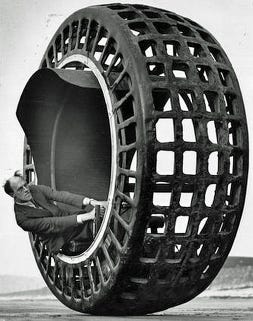one-wheeled car?
Kevin's Newsletter #30
The Dynasphere (sometimes misspelt Dynosphere) was a monowheel vehicle design patented in 1930 by Dr J. A. Purves from Somerset, UK. Purves' idea for the vehicle was inspired by a sketch made by Leonardo da Vinci.
In the early 1930s, the car of the future had just one wheel. That wheel, in fact, was the entire car. The Dynasphere, as inventor Dr J. H. Purves called it, offered a cabin within the circumference of the wheel for the driver and passenger to sit. Purves made two prototypes. The larger one featured a gasoline motor capable of 2.5-horsepower—enough to propel the thousand-pound wheel. The other ran on electricity.
In 1935, Purves developed a bus version to hold more passengers. Had it not been for difficulties in steering and braking, perhaps one-wheeled electric cars and buses would’ve taken over the roads and changed the course of automotive history.
The Da Vinci Connection
In 1930, Dr. John Archibald Purves, a fellow of the Royal Society of Edinburgh made and patented a monowheel vehicle that he built, inspired from a Leonardo Da Vinci sketch.
Of course, this is not the first time someone got Vincinspired and made a monowheel. Back in 1869, French national Rousseau of Marseilles built the very first monowheel vehicle in which the rider sat inside the wheel, steered it by shifting their weight in the direction needed, and basically left their safety to chance. The big wheel remained in the driver’s line of sight at all times, and if that were not enough, sudden braking would cause the rider to roll along with the wheel. Much like a gerbil running on its wheel.
Mechanics
The driver’s seat as well as the motor and the controls were a singular unit and came mounted on the interior rails of the monowheel with smaller wheels. When powered up, this unit would try and climb up the spherical rails, causing the larger one to start to roll forward. Steering was crude, and not much advanced from the French prototype of before.
This means the driver still had to throw their weight around, quite literally, in a bid to lean the wheel in the direction they wanted to go, lest gravity and other laws of motion take their course. Purves later envisaged that future models could come with gears to shift the inner unit in a lean-to turn the wheel in a better manner.
In fact, in another model made in 1932, a ten-hoop one, Purves added such “tipping” gears. Dr Purves also created the Dynasphere 8, a beach vehicle that could seat eight passengers.
What the issue with this vehicle was the braking. Brake hard enough, and the passengers rolled around like gerbils, and steering, even with gears, was rudimentary at best. Purves initially claimed that the Dynasphere could not be tipped over, but he was proven wrong, literally by himself. He also claimed that much like a kid’s toy, in case the Dynasphere did tip over, it would bob right back up. Due to this issue, people were not convinced by his words.
But when it comes to wheels, the more the merrier, right? We are assuming a lot of the people, even in the ‘30s, were of the same thought process and preferred to drive a vehicle that rode on four wheels, and could be turned by the steering wheel as opposed to a vehicle, that was but one wheel.
But what if the Dynasphere had really taken off? Traffic may have been a bit better, no?
Thank you for reading this edition of Sapience. Please share and subscribe if you liked the content and stay tuned for our next “Sapience”.
Follow us on-
Twitter - @mysapiences
Instagram- @sapience.io
Till next time, Ciao!




